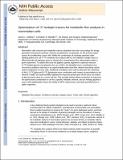Optimization of [superscript 13]C isotopic tracers for metabolic flux analysis in mammalian cells
Author(s)
Walther, Jason L.; Metallo, Christian M.; Zhang, Jie; Stephanopoulos, Gregory
DownloadStephanopoulos_Optimization isotopic.pdf (2.817Mb)
PUBLISHER_CC
Publisher with Creative Commons License
Creative Commons Attribution
Terms of use
Metadata
Show full item recordAbstract
Mammalian cells consume and metabolize various substrates from their surroundings for energy generation and biomass synthesis. Glucose and glutamine, in particular, are the primary carbon sources for proliferating cancer cells. While this combination of substrates generates static labeling patterns for use in [superscript 13]C metabolic flux analysis (MFA), the inability of single tracers to effectively label all pathways poses an obstacle for comprehensive flux determination within a given experiment. To address this issue we applied a genetic algorithm to optimize mixtures of [superscript 13]C-labeled glucose and glutamine for use in MFA. We identified tracer combinations that minimized confidence intervals in an experimentally determined flux network describing central carbon metabolism in tumor cells. Additional simulations were used to determine the robustness of the [1,2-[superscript 13]C[subscript 2]]glucose/[U-[superscript 13]C[subscript 5]]glutamine tracer combination with respect to perturbations in the network. Finally, we experimentally validated the improved performance of this tracer set relative to glucose tracers alone in a cancer cell line. This versatile method allows researchers to determine the optimal tracer combination to use for a specific metabolic network, and our findings applied to cancer cells significantly enhance the ability of MFA experiments to precisely quantify fluxes in higher organisms.
Date issued
2011-12Department
Massachusetts Institute of Technology. Department of Chemical EngineeringJournal
Metabolic Engineering
Publisher
Elsevier
Citation
Walther, Jason L., Christian M. Metallo, Jie Zhang, and Gregory Stephanopoulos. “Optimization of [superscript 13]C Isotopic Tracers for Metabolic Flux Analysis in Mammalian Cells.” Metabolic Engineering 14, no. 2 (March 2012): 162–171.
Version: Author's final manuscript
ISSN
10967176
1096-7184